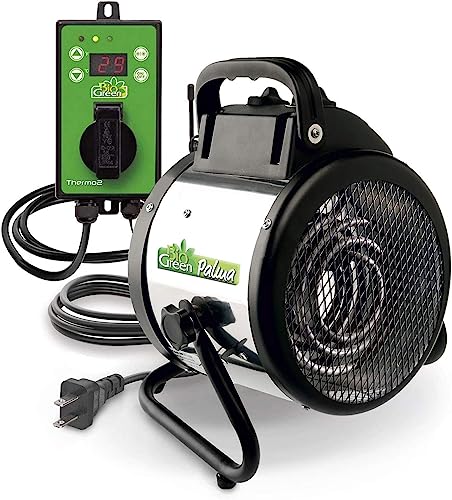If your basement remains idle, one solution to transform it into something useful is turning it into a greenhouse. To Build Indoor Greenhouse in Basement, it can provide the ideal opportunity for cultivating flowers and plants or even starting your own vegetable garden.
Before turning your basement into a greenhouse, there are a few essential points you need to remember. Learning about the basics are important, like soli, airflow, heating, and humidity levels. These are important indoor greenhouse ideas to know before you proceed.
Unused basements have so much potential — why not turn yours into a haven for plants? Even though it takes effort to make a damp, dark room fit for houseplants, living with thriving greenery is worth it. Here’s how you can turn your unused space into a greenhouse.
Table Of Contents
- 1 Tips To Build Indoor Greenhouse in Basement
- 2 1. Choose the Right Soil
- 3 2. Create Consistent Airflow
- 4 3. Have Adequate Heating
- 5 4. Get Special Lighting
- 6 5. Balance Humidity Levels
- 7 6. Pick the Right Pots
- 8 7. Choose Plant Types
- 9 8. Prepare Fertilizer
- 10 9. Pick the Right Location
- 11 10. Simulate Seasonal Changes
- 12 Transform Your Space
Tips To Build Indoor Greenhouse in Basement
1. Choose the Right Soil

Indoor houseplants need quality dirt because they can’t get their nutrients naturally. The combination of peat moss, vermiculite and compost boosts plant growth and health dramatically, so it should be your go-to blend. However, you can also use coconut fiber, sand, potting soil, perlite or gravel.
Besides nutrient quality, drainage is one of the top factors to consider when choosing growing mediums. If the materials you use hold water for too long, your plants could get root rot and die. Many species require different blends, so research before settling on one.
2. Create Consistent Airflow

To Build Indoor Greenhouse in Basement, finding the right airflow matters more. While basements usually get the occasional draft, they rarely have good air circulation. However, plants need airflow to stay healthy. Excess condensation builds up without it, and they risk getting mold or rot. Also, flowering species need a steady, low breeze for pollination.
- 4-TIER GREENHOUSE KIT - The 4 tiers of sturdy shelving in this small greenhouse are 27-inches-wide, have 14-inches of height spacing, and hold up to 24lbs each to provide ample room for trays, pots, or planters for small to medium plants
- INDOOR OR OUTDOOR - The portable greenhouse is ideal for both indoor and outdoor use on your porch, patio, deck, or sunroom. The PVC cover features a zippered roll-up door that protects plants from frost or pests to create an ideal growing environment
- PORTABLE DESIGN - Equipped with locking wheels, this indoor greenhouse can easily be moved from room to room or fixed in place by removing the wheels altogether. The small greenhouse for outdoors is also easy to assemble with no tools required
- VERSATILE USE - This indoor or outdoor greenhouse is a perfect way to extend your growing season for various herbs, vegetables, and fruit-bearing plants, as well as for showcasing beautiful perennials or holding gardening supplies in the offseason
Since houseplants can only thrive when they have enough airflow, you must get ventilation. Ceiling, standing or box fans can do the trick. However, you might need more than one if your space is sizable.
3. Have Adequate Heating
Even though some plants can withstand low temperatures, they prefer to stay reasonably warm. Basements are typically underground and separate from the rest of a home, so they’re much colder. Space heaters or heat lamps are essential to keep your plants healthy in your mini greenhouse.
Since a home loses as much as 50% of its heat through an uninsulated basement — even when the rest of the building is well-insulated — it’s best to patch leaks before starting. Ensure you tightly seal windows and doors. Plug gaps or cracks in your foundation.
- TWO SEPARATELY ADJUSTABLE HEATING ELEMENTS: 750 watts or 1500 watts power. The heater is ideal for rooms up to 130 ft² with an average height of 6.6 feet.
- PRECISE TEMPERATURE CONTROL: The thermostat automatically starts and stops the heater when the desired temperature is reached. The temperature range is from -58°F to 210.2°F.
- AIR CIRCULATION MODE: Activating the air circulation mode turns the heater into a fan. The air movement prevents heat buildup around plants.
- QUICK AND EVEN AIR CIRCULATION: The air circulation heater is very efficient and easily circulates up to 5800 ft³ of air per hour. Since the heater does not run as long, you save electricity and money.
4. Get Special Lighting
Basements don’t often get enough sunlight, so it’s up to you to simulate it with artificial light. Try to mimic the natural environment as much as possible — set your lamp on a timer and adjust its intensity as necessary. Although the amount you need depends on the number of plants you have, most setups require more than one.

Various colors of light inspire plants to do different things. For example, red encourages them to flower and produce fruit. While you could pick one specific type, a full-spectrum lamp is ideal. It gives them everything they need to grow and flower.
- 【"V-shaped" Housing Design】 Professional T8 grow Light Strip has two rows of high-quality full spectrum LED chips. Compared with the grow light fixture with single row of chips, it has a wider beam angle and higher PAR value. Perfect for plant seedling, growth, flowering and bear fruit.
- 【Full Spectrum】 Monios-L LED grow light Strip is providing indoor plants with full-spectrum sunlight replacement at 400nm-800nm. Meanwhile, Monios-L small "V-shaped" housing design is up to 24w each light, so you can install more lights in the same space to get more PPFD( photosynthetic photon flux density ), which is effectively promotes the chlorophyll synthesis and photosynthesis.
- 【Efficient Heat Dissipation】 Monios-L T8 led grow light with aluminum housing provides the high-efficiency heat dissipation, ensuring a longer service life of the led chips. The 24W double-row led chips with high brightness and low light decay, 2900K color temperature makes it look more comfortable.
- 【Easy to Install】 Could connect up to 6 tube lights together with seamless connectors or connector cables by the extendable design. It is suitable for various application such as plant shelves, plant tents, hydroponics growing rooms, greenhouses, etc. Excellent choices for commercial growers and home gardeners.
5. Balance Humidity Levels
Houseplants like humidity, but there must be balance. Too much causes mold and rot, and not enough makes them dry out and wither. The best approach is to get a gauge to monitor it. If you notice its level isn’t ideal, use a humidifier or dehumidifier to correct it.
Remember that different species prefer varying degrees of moisture. For example, desert plants thrive in dry climates, while most herbs prefer to stay damp. You’ll need to find where their acceptable humidity ranges overlap to grow a wide variety of houseplants.
6. Pick the Right Pots
The pots you choose play a prominent role in your houseplants’ health. What they’re made of may not seem important, but it is. For example, terra cotta maximizes airflow, preventing rot and mold buildup. Other popular options are clay, ceramic, plastic and concrete. Some are better for certain species than others.
The other main thing to consider when choosing pots is how they handle water. Always ensure your containers have drainage holes — they protect plants from root rot. You probably don’t want puddles all over your basement, so remember to pick up drip trays, too.
Alternatively, you could skip traditional pots and use a hydroponic growing system. While most prebuilt setups are great, you don’t need a fancy tower. Instead, you can simply use water-filled jars. Most plant cuttings and herbs thrive in a soilless medium.
As a bonus, you won’t have to water nearly as frequently.
7. Choose Plant Types
Sometimes, plants won’t grow even with perfect light, temperature and humidity levels. Increase your chances of success by choosing types that prefer cooler, low-light conditions. Leafy greens, air plants and herbs are some of the best choices, but you could also grow native species because they’ve already acclimated to your local environment.
Indoor Herb Plants Example
- Basil
- Chives
- Mint
- Oregano
- Parsley
- Rosemary
- Thyme
Indoor Vegetables Example
- Avocado
- Carrots
- Cucumbers
- Hot peppers
- Lettuce
- Radishes
- Spinach
- Tomatoes
Indoor Fruit Plants Example
- Gooseberries
- Grapes
- Figs
- Lemons & limes
- Mulberries
- Oranges

You also should consider what kind of maintenance or special requirements your houseplants will require. Some may need a miniature trellis to support their weight or a hanging basket for their trailing vines. You must ensure your space can accommodate their unique needs.
8. Prepare Fertilizer
In nature, nutrients replenish naturally from rain and decomposition. Since these processes don’t happen indoors, you sometimes need to simulate them. Most houseplants need fertilizer once they’ve soaked up all the nitrogen and phosphorus in their soil. However, they can be picky about when they want you to apply it.
Houseplants don’t need fertilizer when they’re dormant — usually during colder months — because they leave their growth state to reserve energy. It’s a leftover process from when they had to survive winters. Giving them nutrients to help them grow won’t do anything unless they’re active, so it’s best to wait for spring and summer.
9. Pick the Right Location
Where you place your houseplants is incredibly important because it dictates how they grow. Besides their proximity to artificial light, heat lamps and fans, you should consider how close they are to the floor, other plants and the basement walls. These factors determine what risks they face.
For example, putting plants near a window may seem like a good idea since it gives them access to natural light. However, it exposes them to cold air. Low temperatures and humidity cause ice crystals to form in plant cells, preventing proper water distribution. This can damage — or even kill — houseplants.
You must pick a safe location for your setup. The areas surrounding a basement’s walls and floor are usually cooler because they’re farther underground — where conditions are damp and light doesn’t reach. Because of this, it’s best to keep plants in the center of the room where the air is consistently warmer.
10. Simulate Seasonal Changes
All plants undergo different growth and dormancy stages, even if you grow perennials. Although people have been keeping houseplants for ages, they’re still accustomed to the natural order.
You must adjust your humidity, lighting and temperature with the changing seasons to simulate the environment.
Transform Your Space
Turning an unused basement into a thriving room full of greenery is no small task, but it can be very rewarding. You’ll have a steady supply of organic food if you grow produce and herbs, and plants can also provide countless emotional benefits.
Overhauling the space takes plenty of effort, but it’s well worth it. 🙂











